Palais Royal
Author: Xavier Georges
Publisher: Hans im Glück / Rio Grande Games
Year: 2008
review by

| x |
|
|
|
|
|
|
|
|
|
|
|
|
|
|
|
|
|
|
|
|
|
|
|
|
|
|
|
|
|
|
|
|
|
|
|
|
|
|
|
|
|
|
|
|
|
|
 |
Power, that is what life is all about according to some, and this game is no exception to that rule. This time power has to be obtained by enlisting the most powerful nobles, who stroll around the garden of a Royal Palace. As may be expected from these nobles, they are busy strolling and chatting. The nearby palace, however, is full of activity, with servants that run from room to room in order to obey their master’s commands to lure the nobles into the palace and into the courts of the players. As is usual at each court, all goes with a changing mixture of bribing, sealed letters and gossip. |
|
| x |
|
|
|
|
|
|
|
|
|
|
|
|
|
|
|
|
|
|
|
|
|
|
|
|
|
|
|
|
|
|
|
|
|
|
|
|
|
|
|
|
|
|
|
|
|
|
|
The palace garden consists of a game board where 36 of the 42 noble tiles are placed on the available spaces. The noble tiles show what is needed to earn them: a number of violet and/or turquoise seals, and an amount of money. On the tile is indicated what the tile scores: points and sometimes also a privilege that can be used during the game.
The actual game is played in the others areas of the palace, which consists of nine locations, represented by large tiles that are placed in a three by three grid below the garden. Each player gets the wooden servants in their playing colour.
|
|
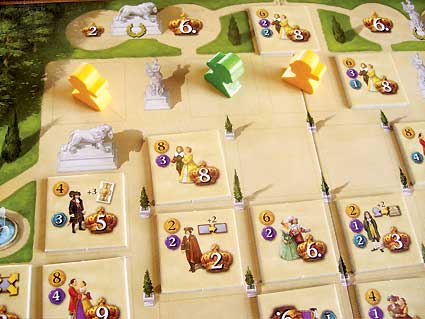 |
|
| x |
|
|
|
|
|
|
|
|
|
|
|
|
|
|
|
|
|
|
|
|
|
|
|
|
|
|
|
|
|
|
|
|
|
|
|
|
|
|
|
|
|
|
|
|
|
|
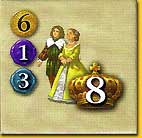 |
xx |
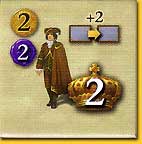 |
|
|
In a player’s turn these servants will be placed and moved around the nine locations of the palace, meanwhile executing the associated actions, hopefully obtaining one or more noble tiles. When a player finished his journey through the palace, it is the next player’s turn. When, at the the starting players turn, there are twelve or fewer nobles left in the garden, each player has one more turn before the game ends.
|
|
| x |
|
|
|
|
|
|
|
|
|
|
|
|
|
|
|
|
|
|
|
|
|
|
|
|
|
|
|
|
|
|
|
|
|
|
|
|
|
|
|
|
|
|
|
|
|
|
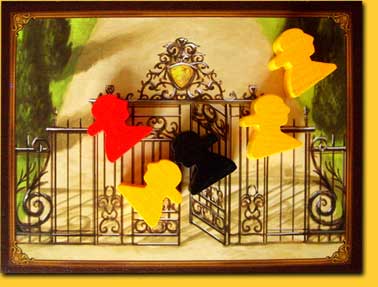 |
First, the players checks how many of his servants are placed on the ‘Parade Ground’. This gives the number of servants he may place on the ‘Gate’ tile. |
|
| x |
|
|
|
|
|
|
|
|
|
|
|
|
|
|
|
|
|
|
|
|
|
|
|
|
|
|
|
|
|
|
|
|
|
|
|
|
|
|
|
|
|
|
|
|
|
|
| Next, the player checks how many spaces his servants in the palace may move by counting his nobles on the ‘Stairway’ tile. He may move his servants around the palace locations, but just horizontally or vertically. |
|
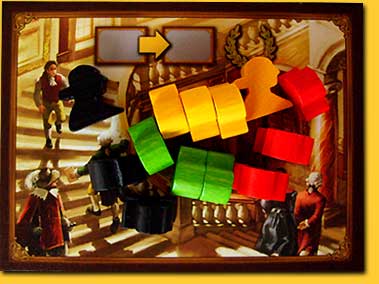 |
|
| x |
|
|
|
|
|
|
|
|
|
|
|
|
|
|
|
|
|
|
|
|
|
|
|
|
|
|
|
|
|
|
|
|
|
|
|
|
|
|
|
|
|
|
|
|
|
|
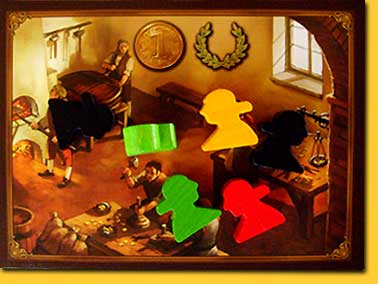 |
Now it is time to collect. First the money: for each of his servants on the ‘Mint’ tile, the player takes one gold coin. |
|
| x |
|
|
|
|
|
|
|
|
|
|
|
|
|
|
|
|
|
|
|
|
|
|
|
|
|
|
|
|
|
|
|
|
|
|
|
|
|
|
|
|
|
|
|
|
|
|
| For enlisting the nobles seals are additionally needed; the number available is indicated by a player’s servant in the ‘King’s Chamber’ for blue seals and at ‘Madame de Pompadour’ cabinet for the violet seals. These seals are not actually taken but merely recalled when the actual collecting of a noble happens. |
|
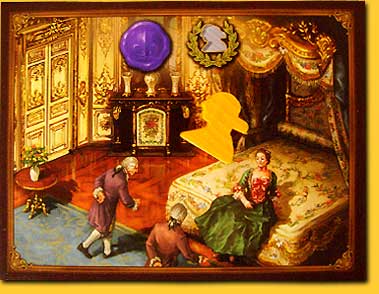 |
|
| x |
|
|
|
|
|
|
|
|
|
|
|
|
|
|
|
|
|
|
|
|
|
|
|
|
|
|
|
|
|
|
|
|
|
|
|
|
|
|
|
|
|
|
|
|
|
|
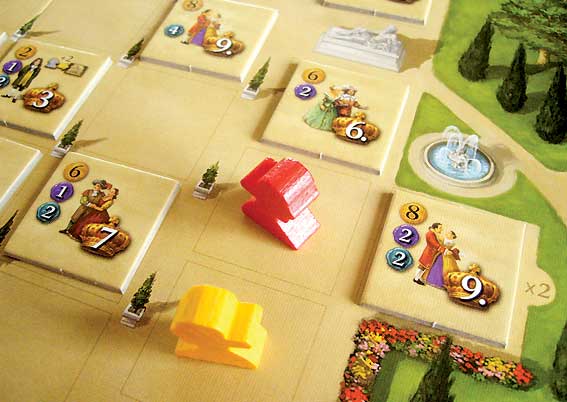 |
|
|
|
|
|
| x |
|
|
|
|
|
|
|
|
|
|
|
|
|
|
|
|
|
|
|
|
|
|
|
|
|
|
|
|
|
|
|
|
|
|
|
|
|
|
|
|
|
|
|
|
|
|
| For each noble a player wants to enlist he needs a servant in the ‘Office’. Now a noble can be taken from the garden, paying for all the requirements. Nice aspect in economical difficult times: the nobles are getting cheaper, as each empty spacee adjacent to a noble’s tile reduces the price by one gold. |
|
|
|
|
|
| x |
|
|
|
|
|
|
|
|
|
|
|
|
|
|
|
|
|
|
|
|
|
|
|
|
|
|
|
|
|
|
|
|
|
|
|
|
|
|
|
|
|
|
|
|
|
|
For each servant on the ‘Back Door’ tile the player draws one card from the supply of privilege cards. If he wants to keep a card, he takes a servant from the tile back to his supply.
All cards give advantages: additional money, points, seals or additional movement. Playing some of the privilege cards requires some payment as indicated on the card. |
|
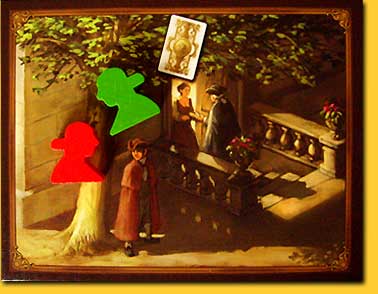 |
|
| x |
|
|
|
|
|
|
|
|
|
|
|
|
|
|
|
|
|
|
|
|
|
|
|
|
|
|
|
|
|
|
|
|
|
|
|
|
|
|
|
|
|
|
|
|
|
|
|
|
|
| x |
|
|
|
|
|
|
|
|
|
|
|
|
|
|
|
|
|
|
|
|
|
|
|
|
|
|
|
|
|
|
|
|
|
|
|
|
|
|
|
|
|
|
|
|
|
|
|
Finally, there is the ‘Cardinal’ tile. Whoever has the most servants here will break the tie to his advantage in the places where this matters during a player’s turn. These places in the castle are indicated with a wreath. If a player has the majority of servants in such a location, he gets the bonus coming with this location. This can be one additional money or seal.
|
|
 |
|
| x |
|
|
|
|
|
|
|
|
|
|
|
|
|
|
|
|
|
|
|
|
|
|
|
|
|
|
|
|
|
|
|
|
|
|
|
|
|
|
|
|
|
|
|
|
|
|
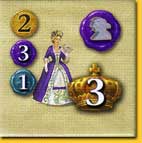 |
xx |
 |
|
|
The nobles need to be carefully selected. Not only the number of points they earn is important; some give less points, but bring a privilege that can be used throughout the game, such as getting two additional gold each turn, or an additional seal. This is not unimportant, since there is a shortage of about everything during the game.
|
|
| x |
|
|
|
|
|
|
|
|
|
|
|
|
|
|
|
|
|
|
|
|
|
|
|
|
|
|
|
|
|
|
|
|
|
|
|
|
|
|
|
|
|
|
|
|
|
|
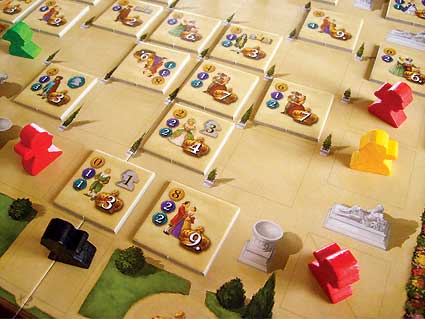 |
|
Also the location of a noble needs to be considered. When a noble tile is taken from one of the four edges of the board, then the empty space has to be filled by a player’s servant. At the end of the game the four edges are scored; the players with most and second most servants score 6 and 2 points respectively. These points are added to the points of all noble tiles and any points from the privilege cards. The player with the most points wins. |
|
| x |
|
|
|
|
|
|
|
|
|
|
|
|
|
|
|
|
|
|
|
|
|
|
|
|
|
|
|
|
|
|
|
|
|
|
|
|
|
|
|
|
|
|
|
|
|
|
| x |
|
|
|
|
|
|
|
|
|
|
|
|
|
|
|
|
|
|
|
|
|
|
|
|
|
|
|
|
|
|
|
|
|
|
|
|
|
|
|
|
|
|
|
|
|
|
| x |
|
|
|
|
|
|
|
|
|
|
|
|
|
|
|
|
|
|
|
|
|
|
|
|
|
|
|
|
|
|
|
|
|
|
|
|
|
|
|
|
|
|
|
|
|
|
 |
|
|
|
|
|
|
|
|
|
|
|
|
|
|
|
|
|
|
|
|
|
|
|
|
|
|
|
|
|
|
|
|
|
|
|
|
|
|
|
|
|
|
|
It is not unusual for a game that it gets a pasted on theme. This doesn not matter as long as the game is good enough. And ‘Royal Palace’ indeed is a good game. Moreover, collecting seals and nobles is a nice change from the usual wood, sand, or iron collecting. The pretty graphics by Michael Menzel again add to the atmosphere.
|
|
| x |
|
|
|
|
|
|
|
|
|
|
|
|
|
|
|
|
|
|
|
|
|
|
|
|
|
|
|
|
|
|
|
|
|
|
|
|
|
|
|
|
|
|
|
|
|
|
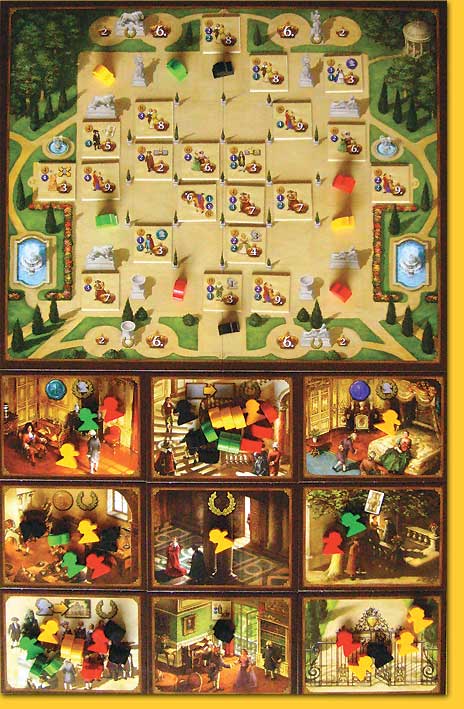 |
|
| x |
|
|
|
|
|
|
|
|
|
|
|
|
|
|
|
|
|
|
|
|
|
|
|
|
|
|
|
|
|
|
|
|
|
|
|
|
|
|
|
|
|
|
|
|
|
|
|
‘Royal Palace’ is a refreshing mix of existing game mechanisms, well playable with any amount of players. We place servants, we try to obtain majorities, but above all each player is busy solving and further optimising his own puzzle as good as possible. A lot of money, seals, and movement is required, not just for the current turn, but some kind of basis also must be established for later turns. The privileges provided by some nobles therefore appear to be essential, and most of them will have gone after the first few turns.
|
|
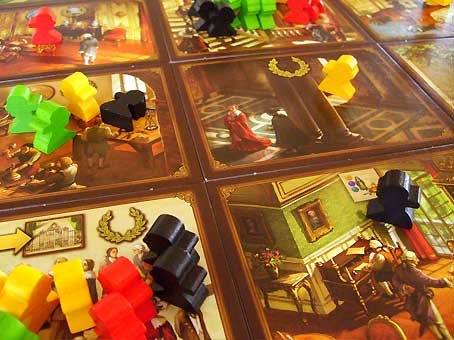 |
|
| x |
|
|
|
|
|
|
|
|
|
|
|
|
|
|
|
|
|
|
|
|
|
|
|
|
|
|
|
|
|
|
|
|
|
|
|
|
|
|
|
|
|
|
|
|
|
|
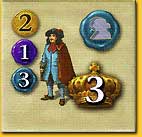 |
xx |
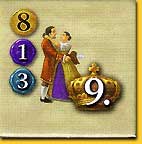 |
|
|
Since the players are busy optimising their own engine of resources, there is a minimum amount of interaction in ‘Royal Palace’. There are some mechanisms in the game to stimulate interaction, like the majority bonuses, but this will typically not lead to large conflicts. Also, if a player is seen to be ‘running away’ in points - usually indicated when he takes the big nine points tiles in an early stage of the game - there is not much the other players can do to stop him. These kinds of aspects may scare away some players, but are no flaw as it should be seen as a feature of the game which you can like or dislike. Another nice aspect of the game is the large variety: the noble tiles will be located differently each game, and also the palace spaces are placed randomly. While a player’s strategy may be more or less fixed by obtaining priviliges and majorities, the tactical elaboration will need to be different each time, providing a long enduring game challenge. |
|
| x |
|
|
|
|
|
|
|
|
|
|
|
|
|
|
|
|
|
|
|
|
|
|
|
|
|
|
|
|
|
|
|
|
|
|
|
|
|
|
|
|
|
|
|
|
|
|
|
Some minor complaints: it is quite difficult to turn back any mistakes a player has made during his turn. After moving the servants around, it is difficult to remember where exactly they came from, so correcting errors or changing your mind may lead to complaints from other players, since they typically cannot check what you were doing. Furthermore, this is typically the kind of game where planning ahead is nearly impossible. When your turn is over, there is nothing to do until the next turn, and then see which nobles are left for you to take, and what the best options are. Especially during the first few games this may lead to long downtimes.
|
|
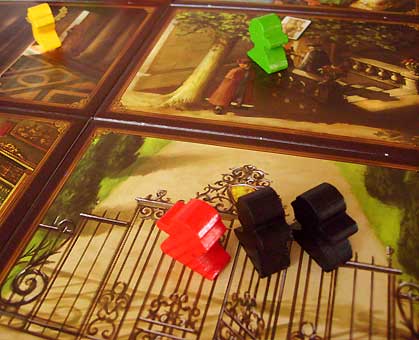 |
|
|
|
|
|
|
|
|
|
|
|
|
|
|
|
|
|
|
|
|
|
|
|
|
|
|
|
|
|
|
|
|
|
|
|
|
|
|
|
|
|
|
|
|
|
|
|
|
Of course, some will see this as an advantage as well, since it will allow them to chat and sit idle, thereby fixing any theme issues they may have…
© 2009 Edwin van de Sluis
Palais Royal, Xavier Georges, Hans im Glück / Rio Grande Games, 2008 - 2 to 4 players, 12 years and up, 60 to 90 minutes
|
|
  |
|
|
|
|
|
|
|
|
|
|
|
|
|
|
|
|
|
|
|
|
|
|
|
|
|
|
|
|
|
|
|
|
|
|
|
|
|
|
|
|
|
|
  |
Long down time between turns, without any incitement to follow the pondering of the other players |
  |
Game has nothing that lifts it above average |
  |
Enormous waiting times in a four player game |
  |
|
|
|
|
|
|
|
|
|
|
|
|
|
|
|
|
|
|
|
|
|
|
|
|
|
|
|
|
|
|
|
|
|
|
|
|
|
|
|
|
|
|
| x |
|
|
|
|
|
|
|
|
|
|
|
|
|
|
|
|
|
|
|
|
|
|
|
|
|
|
|
|
|
|
|
|
|
|
|
|
|
|
|
|
|
|
|
|
|
|
| x |
|
|
|
|
|
|
|
|
|
|
|
|
|
|
|
|
|
|
|
|
|
|
|
|
|
|
|
|
|
|
|
|
|
|
|
|
|
|
|
|
|
|
|
|
|
|
 |
|
|
|
|
|
|
|
|
|
|
|
|
|
|
|
|
|
|
|
|
|
|
|
|
|
|
|
|
|
|
|
|
|
|
|
|
|
|
|
|
|
|
 |
|
|
|
|
|
|
|
|
|
|
|
|
|
|
|
|
|
|
|
|
|
|
|
|
|
|
|
|
|
|
|
|
|
|
|
|
|
|
|
|
|
|
| x |
|
|
|
|
|
|
|
|
|
|
|
|
|
|
|
|
|
|
|
|
|
|
|
|
|
|
|
|
|
|
|
|
|
|
|
|
|
|
|
|
|
|
|
|
|
|
 |
|
|
|
|
|
|
|
|
|
|
|
|
|
|
|
|
|
|
|
|
|
|
|
|
|
|
|
|
|
|
|
|
|
|
 |
|
|
|
|
|
|
|
|
|
|
|
|
|
|
|
|
|
|
|
|
|
|
|
|
|
|
|
|
|
|
|
|
|
|